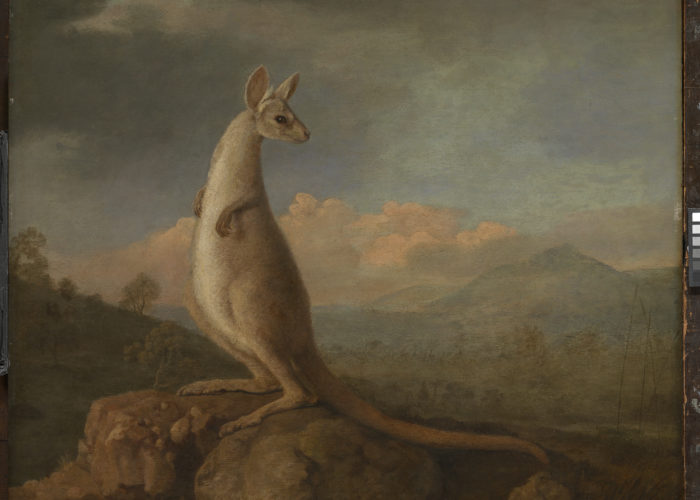George Stubbs’ ‘The Kongouro from New Holland’ (Kangaroo)
Theme: The arts in the Age of Revolution, Social and cultural revolution, People in motion: exiles and opportunities
This is a painting of an Australian kangaroo by the artist George Stubbs. This was the first time people in Britain had seen such a creature.
In the late 1700s, British sailor Captain James Cook and his crews made three voyages to the Southern Hemisphere. At this time, very few people from Europe had travelled to this area of the world and most mistakenly believed there was a large and mysterious ‘Southern Continent’ to be discovered. Cook’s three voyages transformed British knowledge and understanding about the wider world and its people.
Animals like kangaroos and dingos would have seemed like ‘alien’ species.
The ships were crewed by sailors, scientists and artists. They were like floating laboratories, packed with equipment to help them explore, chart and bring back knowledge of the seas, lands, peoples, plants and animals they encountered. Cook’s voyages took them to Australia, New Zealand, Tahiti and to the edge of the Arctic Circle – further than Europeans had ever travelled before.
For people living in Britain in the 1700s, these lands would have been as distant and unreachable a world as outer space is for most of us today. Animals like kangaroos and dingos would have seemed like ‘alien’ species. When they returned from the first voyage, crew member and scientist Joseph Banks commissioned the best animal painter of the time, George Stubbs, to create a painting of a kangaroo, to show people in Britain what it looked like. This helped to generate new thinking about the relationships between different species. Stubbs had, of course, never seen a kangaroo in real life – and never did. He created this painting from sketches, descriptions and a stuffed kangaroo skin that Banks brought back with him.
Did you know..?
Two NASA Space Shuttles were named after Captain Cook’s ships: Endeavour and Discovery
Sources & acknowledgements
This object description and its related educational resources were researched and written by our team of historians and education specialists. For further information see the item’s home museum, gallery or archive, listed above.
- Enquiry Questions
-
Did you know..?
Two NASA Space Shuttles were named after Captain Cook’s ships: Endeavour and Discovery
-
Education overview
You can access a range of teachers resources related to this object and more on our education page.
Please also see our glossary of terms for more detailed explanations of the terms used.
-
Curatorial info
- Originating Museum: Royal Museums Greenwich
- Production Date: 1772
- Creator: George Stubbs
- Original record
-
Use this image
You can download this image for personal and educational use but please take note of the license type and rights holder information.
- Rights Holder: National Maritime Museum, Greenwich, London
- License Type: All Rights Reserved
Find it here
This object is in the collection of Royal Museums Greenwich



